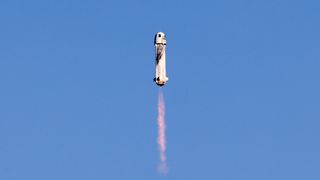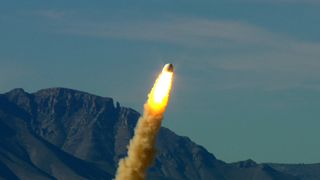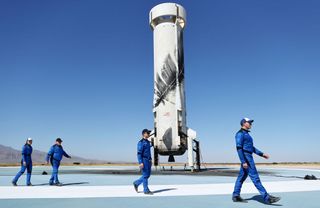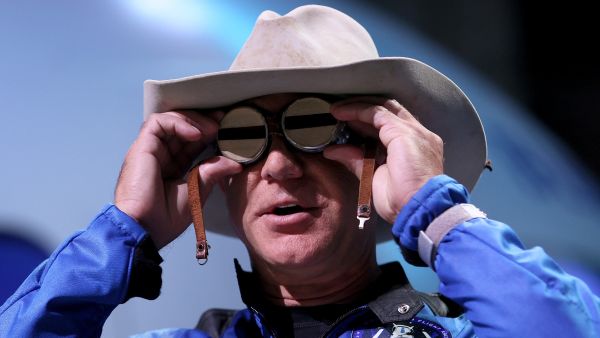Blue Origin: Everything you need to know about the private spaceflight company
Blue Origin flies space tourists to the final frontier.

Blue Origin is a private spaceflight company started by Amazon.com founder Jeff Bezos in 2000. It was the first company in the world to successfully land a reusable rocket on a landing pad, a feat pulled off by the New Shepard suborbital vehicle during a test flight in November 2015 (and many times thereafter).
Blue Origin uses New Shepard to launch space tourists on brief flights and also aims to launch people and payloads to orbit, using a new rocket still under development called New Glenn.
Related: Blue Origin plans to fly all-female crew to suborbital space: report
Blue Origin's first crewed New Shepard mission was on July 20, 2021. It was a suborbital jaunt that launched Bezos, his brother Mark, pioneering aviator Wally Funk and 18-year-old Oliver Daeman. (Daeman took the place of a still-mysterious person who paid $28 million for his or her seat in an online auction, but pulled out of the July 20 flight due to scheduling conflicts, according to Blue Origin.)
The company has flown six crewed flights, but those were suspended on Sept. 12, 2022, when an uncrewed New Shepard anomaly saw the spacecraft disengage itself from the rocket mid-flight due to an issue in the first stage's nozzle. The Federal Aviation Administration performed an investigation, and Blue Origin may return to flight in late 2023 or sometime in 2024 depending on how fixing the problem goes.
"The direct cause of the NS-23 mishap was a thermo-structural failure of the engine nozzle. The resulting thrust misalignment properly triggered the crew capsule escape system, which functioned as designed throughout the flight," Blue Origin officials wrote in a blog post on March 24, 2023. Emphasizing they will return to flight "soon", the blog post noted that the capsule and payloads all came back to Earth, "and will be flown again."
Who owns Blue Origin?
Blue Origin is owned by Jeff Bezos. Bezos is a multibillionaire who got his fortune from founding e-commerce giant Amazon in 1994. Bezos founded Blue Origin in 2000.
How much is a Blue Origin flight?
Blue Origin has not disclosed how much flights for space tourists cost.
How high does Blue Origin fly?
Blue Origin flies beyond the Kármán line, a boundary 62 miles (100 kilometers) above Earth that the International Astronautical Federation defines as the beginning of space. For NASA and the U.S. military, for example, space starts at just 50 miles (around 80 kilometers).
How it started

Blue Origin is known in the space industry for not releasing much information about its flights and aspirations ahead of time, unlike companies such as SpaceX and Virgin Galactic. Blue Origin was registered as a company in 2000 but didn't garner much public attention until 2006 when Bezos made a series of land purchases in Texas.
According to the Wall Street Journal, these purchases were made under names such as "James Cook L.P.," "Jolliet Holdings," "Coronado Ventures" and "Cabot Enterprises," which all traced back to the same address. The corporate names were based on famous explorers.
Blue Origin received two rounds of funding from NASA: $3.7 million in 2010 for the first round of the Commercial Crew Program, and $22 million for the second round in 2011.
The company's first major disclosed setback came in 2011 when a development vehicle failed at around 45,000 feet (13,700 meters) in altitude during a flight test.
"A flight instability drove an angle of attack that triggered our range safety system to terminate thrust on the vehicle. Not the outcome any of us wanted, but we're signed up for this to be hard," Bezos wrote in a Sept. 2, 2011, update to the company's website.
He added that the company was already working on another development vehicle. The next "short hop" took place in November 2011.
October 2012 saw tests of the crew capsule escape system; the company dubbed the event "a great day in Texas" on its website. The system soared to 2,307 feet (703 m) before returning to Earth by parachute.
"The progress Blue Origin has made on its suborbital and orbital capabilities really is encouraging for the overall future of human spaceflight," NASA Commercial Crew Program manager Ed Mango said in a statement at the time. "It was awesome to see a spacecraft NASA played a role in developing take flight."
However, as the Commercial Crew program continued, NASA chose rival systems —SpaceX's Dragon and Boeing's CST-100 Starliner — to provide crewed flights to and from the International Space Station. This left Blue Origin reliant on finding other customers to eventually support its work. One of the income streams Blue Origin is pursuing for New Shepard — which is named after Mercury astronaut Alan Shepard — is space tourism.
Related: Space tourism, 20 years in the making, is finally ready for launch
What happens during a Blue Origin space tourism flight?

Here's what space tourists experience: New Shepard lifts off using the rocket's BE-3PM engine, which will burn for about two minutes and 45 seconds. After the main engine cutoff, the crew capsule separates from the rocket. Passengers are weightless for about four minutes, and see the Earth's curvature from an altitude of about 307,000 feet (93,573 m). The spacecraft then re-enters the atmosphere for a safe landing on Earth, about 11 minutes after liftoff. The rocket, meanwhile, comes down for a powered, vertical landing at its designated touchdown pad.
New Shepard has undergone multiple iterations over the years, making 15 test launches with scientific experiments and other payloads to suborbital space as of mid-July 2021, just before the pioneering flight with people on board.
The company has faced criticisms for its safety practices, however. Bezos has said that the tourists would not wear spacesuits, which goes against safety practices for all major space agencies including NASA. (Competitor Virgin Galactic also does not require spacesuits, however.) Safety practices were also criticized in an essay published by 21 past and current Blue Origin employees in a detailed essay published by the Lioness on Sept. 30, 2021, shortly after Bezos' flight. Their wide-ranging concerns touched on matters such as the company discouraging dissent, Blue Origin honoring the schedule instead of safety, and problems with sexism and sustainability, among other matters.
Related: As space billionaires take flight, 'the right stuff' for space travel enters a new era
Reusable rocket flights
One of the frontiers of space exploration right now is creating reusable rockets. SpaceX is another company that has been working on the concept for years, but Blue Origin beat them to the punch in landing on solid ground several weeks before SpaceX.
That moment came on Nov. 23, 2015, during a New Shepard suborbital test flight. The rocket and vehicle separated as usual, but the rocket did not fall back to Earth. Instead, it moved toward a landing pad and softly touched down with the assistance of its engines.
"Rockets have always been expendable. Not anymore," stated a blog post on the company's website written by Bezos. (The post is no longer available, but is reported in outlets such as Scientific American.) "Now safely tucked away at our launch site in West Texas is the rarest of beasts, a used rocket. This flight validates our vehicle architecture and design," the post continued.
SpaceX landed the first stage of its two-stage Falcon 9 rocket successfully on land about a month later, in December 2015. This was a different kind of feat, for the Falcon 9 is a more powerful rocket that goes much higher — all the way to Earth orbit.
Blue Origin followed up its world first with a reusability milestone on Jan. 22, 2016, launching the same New Shepard vehicle on another suborbital test flight. (SpaceX has since taken reuse to another level, landing Falcon 9 first stages during orbital launches and reflying used first stages dozens of times each year..)
Other activities
Blue Origin is also working on an orbital launch system called New Glenn, which is named after Mercury astronaut John Glenn. Blue Origin will attempt to make New Glenn available for national security government missions, alongside companies such as United Launch Alliance and SpaceX. Blue Origin is also developing a lander called Blue Moon, which is designed to carry people and payloads to the lunar surface.
In May 2023, NASA selected a Blue Origin-led coalition that will use Blue Moon as an option for its Artemis program to land astronauts on the moon, starting as soon as Artemis 5 in the late 2020s or so. Should Artemis 5 go to plan, Blue Moon will launch on a rocket (not yet announced) to dock with Gateway, a future NASA-led outpost in lunar orbit. The crew will make a separate launch on NASA's Space Launch System rocket in an Orion spacecraft. The astronauts will dock with Gateway and two of the crew will use Blue Moon to fly to the moon's south pole for about a week.
NASA had previously selected SpaceX's Starship vehicle as the sole option for Artemis missions in April 2021. The controversial move excluded competitors, such as another coalition led by Blue Origin. After the agency cited budgetary constraints for the decision, Bezos himself said he was willing to cover billions of dollars in cost as his coalition, along with another led by Dynetics, independently filed protests with the Government Accountability Office. After the protest was denied, Bezos sued NASA; the lawsuit was also overturned. By October 2021, however, the U.S. Senate directed NASA to seek a second lander option for Artemis.
Artemis isn't the only NASA program that Blue Origin is working on. The agency is seeking commercial successors to the International Space Station to fly in the 2030s, and a team including Blue Origin has offered the Orbital Reef space station as an option. Blue Origin's team received $130 million from NASA in December 2021 under a funded Space Act Agreement covering the design phase (two other coalitions were also selected). Orbital Reef, involving Blue Origin, Sierra Space, Boeing and several others, passed its system definition review in 2022.
Blue Origin's business also includes supplying engines, such as the BE-4 that will power the New Glenn orbital rocket. In 2018, Blue Origin signed a deal to provide the BE-4 to United Launch Alliance, which will use it on the first stage of its Vulcan Centaur vehicle, the successor to the Atlas V. Vulcan Centaur is scheduled to launch for the first time in 2023 or so, on a mission that will send Astrobotic's Peregrine lander to the moon.
The company was also an entrant in NASA's Commercial Crew program that sends astronauts to the ISS. NASA provided Blue Origin with more than $25 million in contracts (payment was based upon milestones completed) during the early stages of the spacecraft development, along with several other companies. In 2014, NASA chose to support SpaceX's Dragon and Boeing's Starliner spacecraft for future astronaut flights.
Blue Origin Q&A
This Q&A is based upon the first televised interview that Bezos gave publicly after returning from space on July 20, 2021.

Jeff Bezos is the founder and former chief executive officer of Amazon. Bezos also founded Blue Origin in 2000, and bought the Washington Post in 2013. He is also one of the richest people in the world.
We all want to know the reality of seeing the Earth from above. Did it live up to the dream?
Honestly, I’m not talented enough to describe this in words. I can't figure it out. It was much more than I expected. It's awe-inspiring.
Now that you've accomplished this, what's Blue's next move? How does this fit into the long-term vision?
We're building an orbital vehicle called New Glenn. And this vehicle we just flew, New Shepard is our suborbital tourism vehicle. So we're going to fly that over and over and over every time we fly it. It's practice for the orbital mission.
Talk to us about how you believe this will help benefit us here on Earth.
What we're doing is we're building infrastructure. This is a road, building a road to space so that future generations can build the future.
Additional resources
Learn more about Blue Origin and register for flight opportunities on the company's website. Rewatch the first flight by New Shepard on Blue Origin's YouTube channel. Keep up to date on Blue Origin's activities on X.
Bibliography
Abrams, Alexandra et. al. (2021, Sept. 30). "Bezos Wants to Create a Better Future in Space. His Company Blue Origin Is Stuck in a Toxic Past." The Lioness. https://www.lioness.co/post/bezos-wants-to-create-a-better-future-in-space-his-company-blue-origin-is-stuck-in-a-toxic-past
Bezos, Jeff. (2011, Sept. 2). "Successful Short Hop, Setback, and Next Vehicle." Blue Origin News. https://www.blueorigin.com/news/successful-short-hop-setback-and-next-vehicle
Blue Origin. (2023, March 24). "Blue Origin NS-23 Findings." Blue Origin News. https://www.blueorigin.com/news/ns-23-findings
Cofield, Calla. (2015, Nov. 24). "Blue Origin Makes Historic Reusable Rocket Landing in Epic Test Flight." https://www.scientificamerican.com/article/blue-origin-makes-historic-reusable-rocket-landing-in-epic-test-flight/
Mangalindan, Mylene. (2006, Nov. 10). "Buzz in West Texas Is About Jeff Bezos And His Launch Site." The Wall Street Journal. https://www.wsj.com/articles/SB116312683235519444
Join our Space Forums to keep talking space on the latest missions, night sky and more! And if you have a news tip, correction or comment, let us know at: community@space.com.
Get the Space.com Newsletter
Breaking space news, the latest updates on rocket launches, skywatching events and more!

Elizabeth Howell (she/her), Ph.D., is a staff writer in the spaceflight channel since 2022 covering diversity, education and gaming as well. She was contributing writer for Space.com for 10 years before joining full-time. Elizabeth's reporting includes multiple exclusives with the White House and Office of the Vice-President of the United States, an exclusive conversation with aspiring space tourist (and NSYNC bassist) Lance Bass, speaking several times with the International Space Station, witnessing five human spaceflight launches on two continents, flying parabolic, working inside a spacesuit, and participating in a simulated Mars mission. Her latest book, "Why Am I Taller?", is co-written with astronaut Dave Williams. Elizabeth holds a Ph.D. and M.Sc. in Space Studies from the University of North Dakota, a Bachelor of Journalism from Canada's Carleton University and a Bachelor of History from Canada's Athabasca University. Elizabeth is also a post-secondary instructor in communications and science at several institutions since 2015; her experience includes developing and teaching an astronomy course at Canada's Algonquin College (with Indigenous content as well) to more than 1,000 students since 2020. Elizabeth first got interested in space after watching the movie Apollo 13 in 1996, and still wants to be an astronaut someday. Mastodon: https://qoto.org/@howellspace
